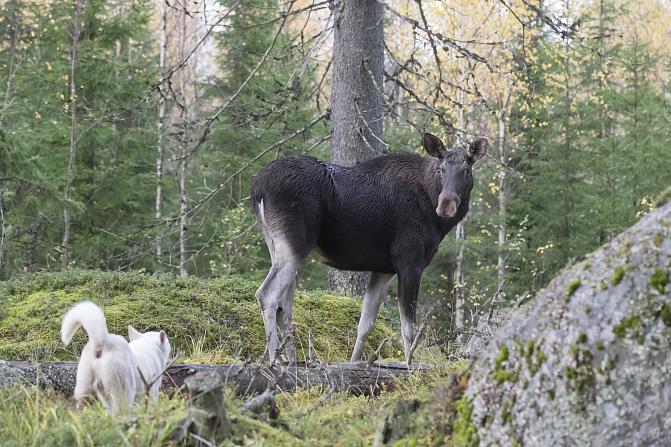Every year, wolves kill and injure domestic and production animals in Finland. For peaceful coexistence, it is important to develop effective ways to protect animals.
South of the reindeer husbandry area, wolves cause the most significant losses for sheep. Currently, some 400–500 sheep deaths caused by wolves are registered every year. In addition, the Government pays compensation each year for some 50 dogs injured or killed by wolves. Hunting dogs working farther away from people most often end up being killed by wolves.
Domestic animals can be protected from carnivores in various ways. For example, a correctly erected and regularly maintained electric fence is an effective way to protect grazing animals (Pellikka, 2020). However, not all protection methods can be used on all farms. Solutions must be customised for each farm according to its production line, the location of pastures and the terrain.
Goal:
Reducing losses of domestic animals and dogs by developing tools and sharing animal protection expertise.
Measures:
- Planners from the Finnish Wildlife Agency visited farms and planned animal protection with farmers.
- New deterrents were imported to Finland, and their effectiveness was tested with farmers. Domestic animal farms were able to obtain fence material from the Finnish Wildlife Agency funded by the LIFE BOREALWOLF project.
- Protective dog vests were tested with hunters.
Results
Domestic animal farms received support and help
It is important that domestic animal farmers’ concerns about wolves are taken seriously, and people are not left alone with challenges. There has been a clear need for guidance and support, as the numerous people who contacted the project planners indicate.
The challenge is often that a fence is requested as animal protection after depredation has already occurred. The project adopted a proactive approach: when the grazing period started, the planners identified farms involving the highest risk of wolf depredation and contacted the farmers.
Domestic animal farmers regarded cooperation with the project as effective and all the equipment, especially cameras and electric fences, as mainly useful. Fifty-three farmers responded to the survey sent to domestic animal farms, of whom 89% considered that the project measures would also be needed in the future.
New protection methods diversified the toolkit
New types of protection methods were also tested in the project. They included GPS trackers to monitor the movement of sheep and take action early, wildlife and CCTV cameras to monitor the edges of pastures, warning lines, and various light and noise scare devices.
No losses occurred on most farms after the deployment of protection methods. Farmers were very interested in trying different methods for difficult situations.
Despite the measures taken during the project, sheep losses caused by wolves increased. This can probably be explained by the larger wolf population, especially in Western Finland, where there are also several sheep farms. It is impossible to determine how much wolf depredation would have increased without the project. The planners had their hands full, and the input of three people was insufficient to help all domestic animal farms. Their phones rang non-stop, especially during the grazing period, and demand was higher than they were able to offer.
Protective vests for hunting dogs were effective in Finnish conditions
Hunters tested the suitability of protective vests for hunting dogs in Finnish conditions and hunting. The results will be published in 2025.
Key figures
- More than 270 visits to farms
- 168 wildlife and CCTV cameras
- 184 light and noise scare devices
- 72 km of electric fences
Contact details
The project ended in 2025. After the end of the project, the Finnish Wildlife Agency can be contacted for questions related to the protection of domestic animals.
Mari Lyly
Finnish Wildlife Agency Ostrobothnia
029 431 2274
mari.lyly(at)riista.fi
